This article needs additional citations for verification .(November 2014) |
A plumbing fixture is an exchangeable device which can be connected to a plumbing system to deliver and drain water.
This article needs additional citations for verification .(November 2014) |
A plumbing fixture is an exchangeable device which can be connected to a plumbing system to deliver and drain water.
The most common plumbing fixtures are:

Each of these plumbing fixtures has one or more water outlets and a drain. In some cases, the drain has a device that can be manipulated to block the drain to fill the basin of the fixture. Each fixture also has a flood rim, or level at which water will begin to overflow. Most fixtures also have an overflow, which is a conduit for water to drain away, when the regular drain is plugged, before the water actually overflows at the flood rim level. However, water closets and showers (that are not in bathtubs) usually lack this feature because their drains normally cannot be stopped.
Each fixture usually has a characteristic means of connection. Normal plumbing practice is to install a valve on each water supply line before the fixture, and this is most commonly termed a stop or "service valve". The water supply to some fixtures is cold water only (such as water closets and urinals). Most fixtures also have a hot water supply. In some occasional cases, a sink may have both a potable (drinkable) and a non-potable water supply.
Lavatories and water closets normally connect to the water supply by means of a supply, which is a tube, usually of nominal 3/8 in (United States) or 10 or 12 mm diameter (Europe and Middle East), which connects the water supply to the fixture, sometimes through a flexible (braided) hose. For water closets, this tube usually ends in a flat neoprene washer that tightens against the connection, while for lavatories, the supply usually ends in a conical neoprene washer. Kitchen sinks, tubs and showers usually have supply tubes built onto their valves which then are soldered or 'fast jointed' directly onto the water supply pipes.
The actual initial drain part in a lavatory or sink is termed a strainer. If there is a removable strainer device that fits into the fixed strainer, it is termed a strainer basket. The initial pipe that leads from the strainer to the trap is termed the tailpiece.
Floor-mounted water closets seal to the toilet flange of the drain pipe by means of a wax ring. These are traditionally made out of beeswax. However, their proper sealing depends on proper seating of the water closet, on a firm and secure base (floor), and on proper installation of the closet bolts which secure the closet to the flange, which is in turn supposed to be securely fastened to the floor.

All plumbing fixtures have traps in their drains; these traps are either internal or external to the fixtures. Traps are pipes which curve down then back up; they "trap" a small amount of water to create a water seal between the ambient air space and the inside of the drain system. This prevents sewer gas from entering buildings.
Most water closets, bidets, and many urinals have the trap integral with the fixture itself. The visible water surface in a toilet is the top of the trap's water seal.
Each fixture drain, with exceptions, must be vented so that negative air pressure in the drain cannot siphon the trap dry, to prevent positive air pressure in the sewer from forcing gases past the water seal, and to prevent explosive sewer gas buildup.


In public facilities, the trend is toward sensor-operated (automatic) fixtures that improve hygiene and save money. For example, sensor operated automatic-flush urinals have fewer moving parts, reduce wear, and tend to last longer than manual-flush valves. Also, they ensure fixtures are flushed only once per use. Some contain intelligence that flushes them at different amounts of water flow depending on traffic patterns: e.g., the fixture can detect a lineup of users and only give a full flush after the last person has used the urinal. For the same purpose, dual-flush toilets are also becoming more popular. A combination of both technologies can allow for saved power and water.
Automatic flush compensates for users who do not bother to flush. Also, since the fixtures are always flushed, there is no need for a urinal cake, or other odor reduction. Sensor-operated toilets also have automatic flush. Sensor-operated faucets and showers save water. For example, while a user is lathering up with soap, the fixture shuts off and then resumes when the user needs it to. Sensor-operated soap and shampoo dispensers reduce waste and spills that might otherwise represent a slippage hazard.
However, many people, especially children, dislike or even fear automatic flush toilets, since they have the tendency to flush without warning, even while the user is still sitting on the toilet. Some parents have started keeping track of public bathrooms that have manual flush toilets, or even carrying post-it notes or other devices with them to temporarily disable the automatic flush sensor. [1]
These fixtures typically cost more to install than conventional plumbing fixtures, because they require the services (or presence) of both a licensed plumber and a licensed electrician. Construction companies on cost-plus contracts may actually favor these fixtures for this reason, although their clients may not. The additional complexity of these fixtures also complicates repairs, particularly the diagnosis of malfunctions causing unexpected flushing. Few electricians, and fewer plumbers, understand microelectronics well enough for complex diagnosis.
Some widely used standards for plumbing fittings and accessories located between the supply stop and the terminal fitting area are:

Plumbing is any system that conveys fluids for a wide range of applications. Plumbing uses pipes, valves, plumbing fixtures, tanks, and other apparatuses to convey fluids. Heating and cooling (HVAC), waste removal, and potable water delivery are among the most common uses for plumbing, but it is not limited to these applications. The word derives from the Latin for lead, plumbum, as the first effective pipes used in the Roman era were lead pipes.
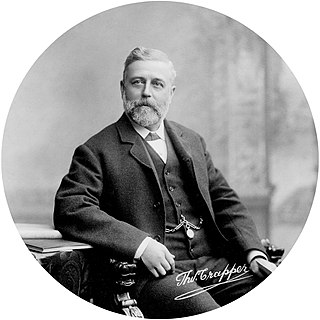
Thomas Crapper was an English plumber and businessman. He founded Thomas Crapper & Co in London, a plumbing equipment company. His notability with regard to toilets has often been overstated, mostly due to the publication in 1969 of a fictional biography by New Zealand satirist Wallace Reyburn.

A bathroom is a room in which people wash their bodies or parts thereof. It can contain one or more of the following plumbing fixtures: a shower, a bathtub, a bidet, and a sink. The inclusion of a toilet is common. There are also specific toilet rooms, only containing a toilet, which in North American English tend to be called "bathrooms", "powder rooms" or "washrooms", as euphemisms to conceal their actual purpose, while they in British and Irish English are known as just "toilets" or possibly "cloakrooms" - but also as "lavatories" when they are public.
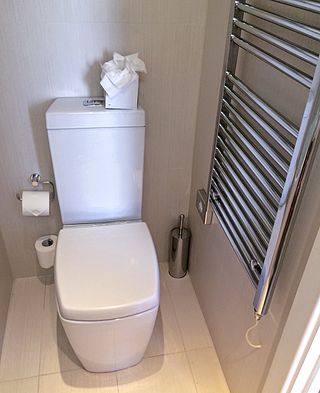
A flush toilet is a toilet that disposes of human waste by using the force of water to channel it through a drainpipe to another location for treatment, either nearby or at a communal facility. Flush toilets can be designed for sitting or squatting, in the case of squat toilets. Most modern sewage treatment systems are also designed to process specially designed toilet paper. The opposite of a flush toilet is a dry toilet, which uses no water for flushing.

A bidet is a bowl or receptacle designed to be sat upon in order to wash a person's genitalia, perineum, inner buttocks, and anus. The modern variety has a plumbed-in water supply and a drainage opening, and is thus a plumbing fixture subject to local hygiene regulations. The bidet is designed to promote personal hygiene and is used after defecation, and before and after sexual intercourse. It can also be used to wash feet, with or without filling it up with water. Some people even use bidets to bathe babies or pets. In several European countries, a bidet is now required by law to be present in every bathroom containing a toilet bowl. It was originally located in the bedroom, near the chamber-pot and the marital bed, but in modern times is located near the toilet bowl in the bathroom. Fixtures that combine a toilet seat with a washing facility include the electronic bidet.
A drain cleaner, also known as drainopener, refers to a person, device, or product used to unblock sewer pipes or clear clogged wastewater drains. This term typically applies to chemical, enzymatic, or mechanical tools such as commercial chemical cleaners, plumber’s snakes, drain augers, bio-enzyme solutions, or toilet plungers. In some contexts, it may also refer to a plumber or professional who specializes in drain cleaning and maintenance.

A tap is a valve controlling the release of a fluid.
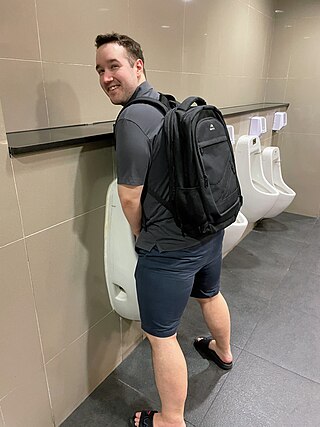
A urinal is a sanitary plumbing fixture for urination only. Urinals are often provided in public toilets for male users in Western countries. They are usually used in a standing position. Urinals can be with manual flushing, automatic flushing, or without flushing, as is the case for waterless urinals. They can be arranged as single sanitary fixtures or in a trough design without privacy walls. Urinals designed for females also exist but are rare. It is possible for females to use stand-up urinals using a female urination device.

A drain-waste-vent system is the combination of pipes and plumbing fittings that captures sewage and greywater within a structure and routes it toward a water treatment system. It includes venting to the exterior environment to prevent a vacuum from forming and impeding fixtures such as sinks, showers, and toilets from draining freely, and employs water-filled traps to block dangerous sewer gasses from entering a plumbed structure.
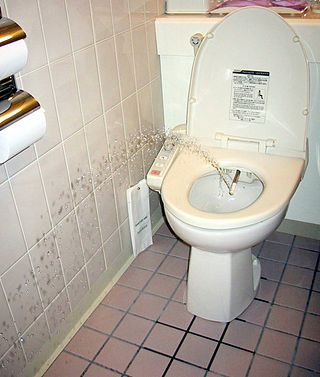
Toilets in Japan are sometimes designed more elaborately than toilets commonly seen in other developed nations. European toilets occasionally have a separate bidet whilst Japan combines an electronic bidet with the toilet. The current state of the art for Western-style toilets in Japan is the bidet toilet, which as of March 2016 is installed in 81% of Japanese households. In Japan, these bidets are commonly called washlets, a brand name of Toto Ltd., and they may include many advanced features rarely seen outside of Asia. The basic feature set commonly found on washlets consists of anal hygiene, bidet washing, seat warming, and deodorization.
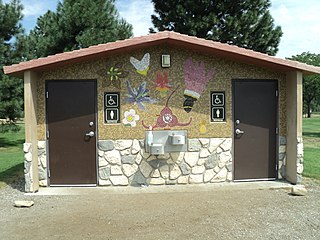
A public toilet, restroom, public bathroom or washroom is a room or small building with toilets and sinks for use by the general public. The facilities are available to customers, travelers, employees of a business, school pupils or prisoners and are commonly separated into male and female toilets, although some are unisex, especially for small or single-occupancy public toilets, public toilets are sometimes accessible to people with disabilities. Depending on the culture, there may be varying degrees of separation between males and females and different levels of privacy. Typically, the entire room, or a stall or cubicle containing a toilet, is lockable. Urinals, if present in a male toilet, are typically mounted on a wall with or without a divider between them. Local authorities or commercial businesses may provide public toilet facilities. Some are unattended while others are staffed by an attendant. In many cultures, it is customary to tip the attendant, especially if they provide a specific service, such as might be the case at upscale nightclubs or restaurants.

A fitting or adapter is used in pipe systems to connect sections of pipe or tube, adapt to different sizes or shapes, and for other purposes such as regulating fluid flow. These fittings are used in plumbing to manipulate the conveyance of fluids such as water for potatory, irrigational, sanitary, and refrigerative purposes, gas, petroleum, liquid waste, or any other liquid or gaseous substances required in domestic or commercial environments, within a system of pipes or tubes, connected by various methods, as dictated by the material of which these are made, the material being conveyed, and the particular environmental context in which they will be used, such as soldering, mortaring, caulking, plastic welding, welding, friction fittings, threaded fittings, and compression fittings.

In plumbing, a trap is a U-shaped portion of pipe designed to trap liquid or gas to prevent unwanted flow; most notably sewer gases from entering buildings while allowing waste materials to pass through. In oil refineries, traps are used to prevent hydrocarbons and other dangerous gases and chemical fumes from escaping through drains. In heating systems, the same feature is used to prevent thermo-siphoning which would allow heat to escape to locations where it is not wanted. Similarly, some pressure gauges are connected to systems using U bends to maintain a local gas while the system uses liquid. For decorative effect, they can be disguised as complete loops of pipe, creating more than one U for added efficacy.
A trap primer is a plumbing device or valve that adds water to traps. The water seals in traps are needed to prevent sewer gases from entering buildings, but because this water is exposed to the air, it is subject to evaporation over time in infrequently used floor drains, leading to the release of sewer gas into the environment. The trap primer mitigates this problem by injecting water, either directly or indirectly, into the trap to maintain the water seal indefinitely.
Sloan Valve Company is a privately held American company specializing in plumbing valves and fixtures.

A floor drain is a plumbing fixture that is installed in the floor of a structure, mainly designed to remove any standing water near it. They are usually round, but can also be square or rectangular. They usually range from 2 to 12 inches ; most are 4 inches (10 cm) in diameter. They have gratings that are made of metal or plastic. The floor around the drain is also level or sloped to allow the water to flow to the drain.

George Jennings was an English sanitary engineer and plumber who invented the first public flush toilets.

A toilet is a piece of sanitary hardware that collects human urine and feces, and sometimes toilet paper, usually for disposal. Flush toilets use water, while dry or non-flush toilets do not. They can be designed for a sitting position popular in Europe and North America with a toilet seat, with additional considerations for those with disabilities, or for a squatting posture more popular in Asia, known as a squat toilet. In urban areas, flush toilets are usually connected to a sewer system; in isolated areas, to a septic tank. The waste is known as blackwater and the combined effluent, including other sources, is sewage. Dry toilets are connected to a pit, removable container, composting chamber, or other storage and treatment device, including urine diversion with a urine-diverting toilet.
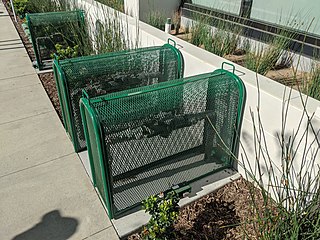
Backflow is a term in plumbing for an unwanted flow of water in the reverse direction. It can be a serious health risk for the contamination of potable water supplies with foul water. In the most obvious case, a toilet flush cistern and its water supply must be isolated from the toilet bowl. For this reason, building codes mandate a series of measures and backflow prevention devices to prevent backflow.
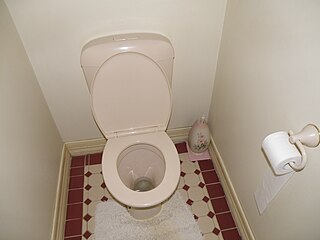
A toilet is a small room used for privately accessing the sanitation fixture (toilet) for urination and defecation. Toilet rooms often include a sink (basin) with soap/handwash for handwashing, as this is important for personal hygiene. These rooms are typically referred to in North America as half-bathrooms in a private residence.